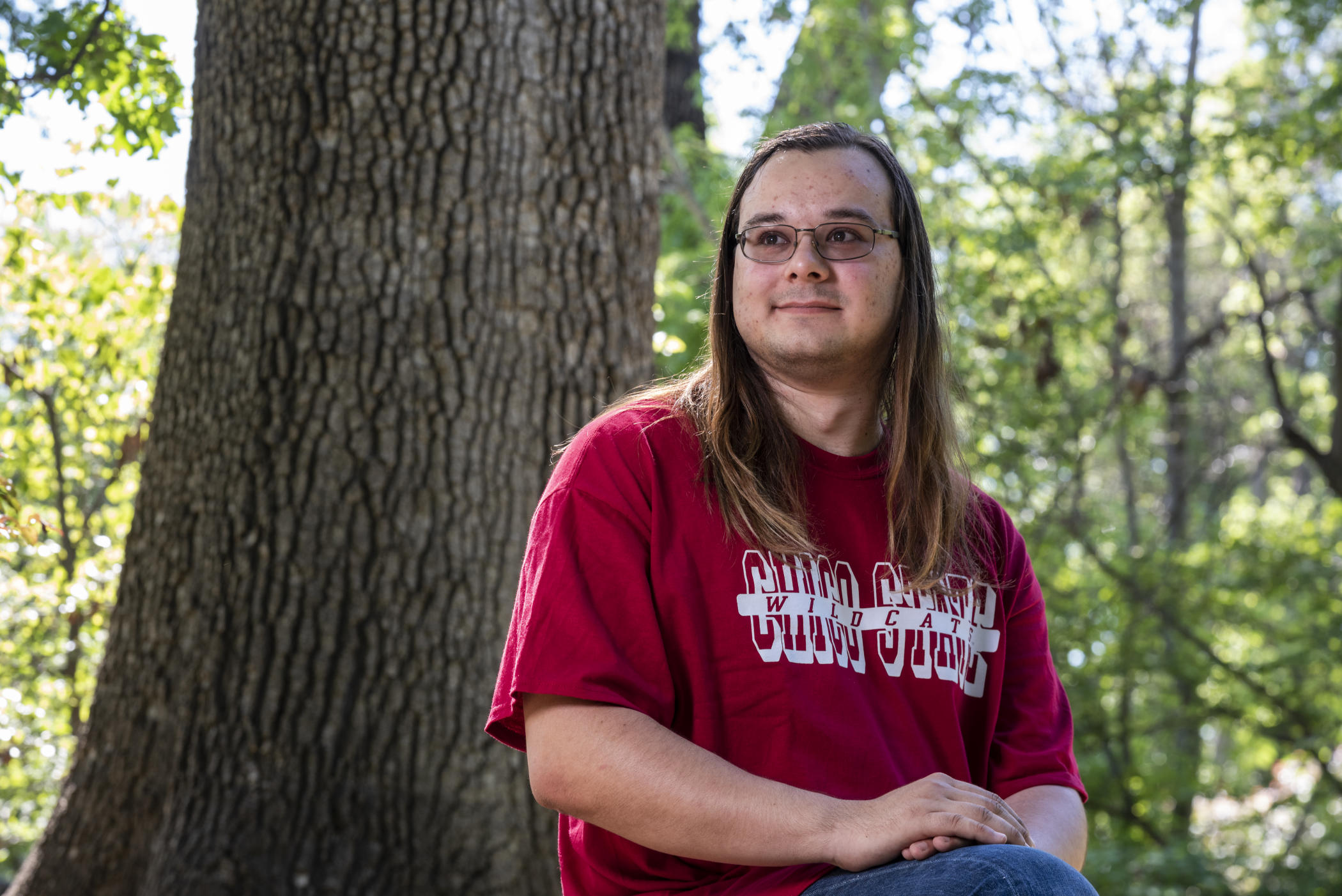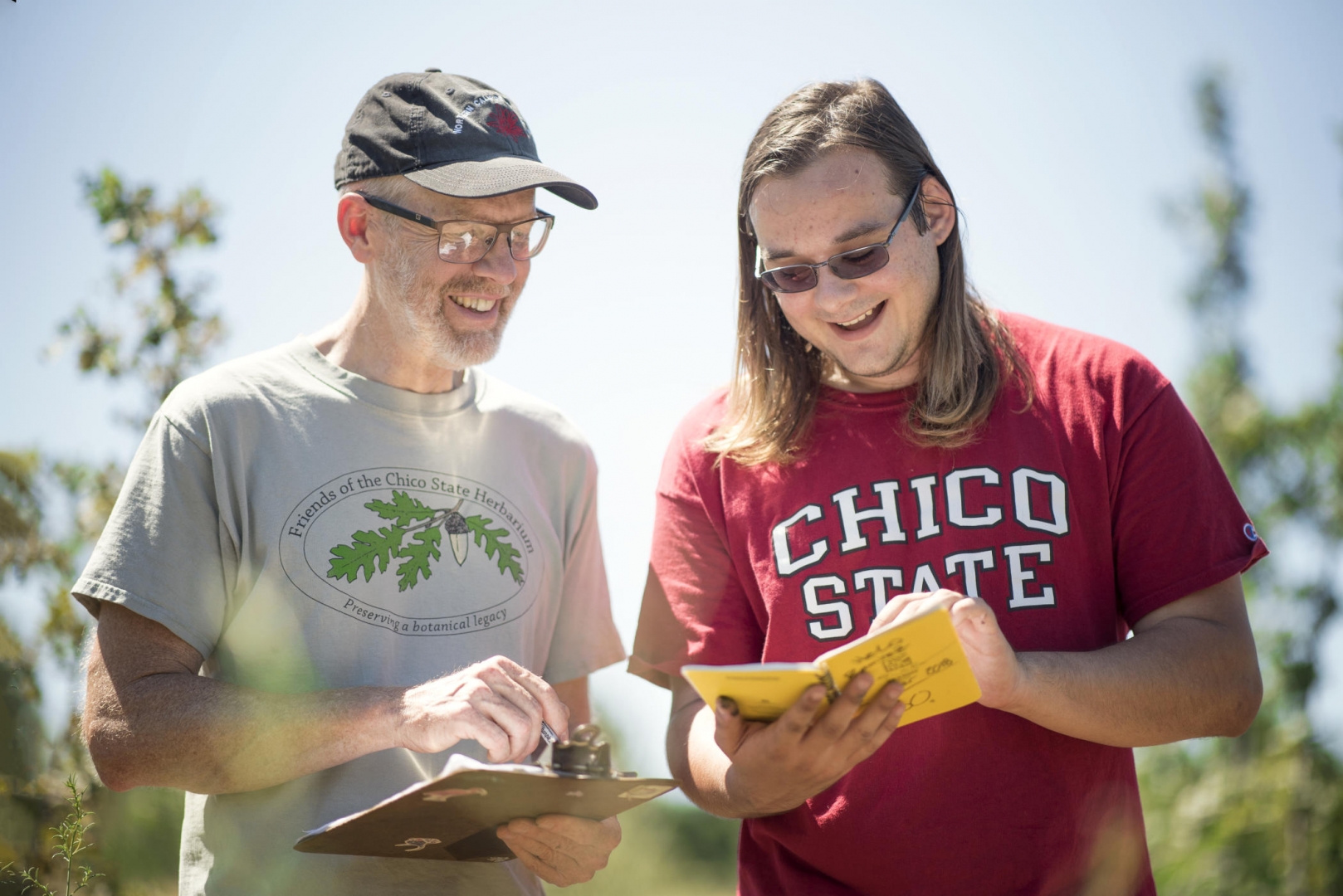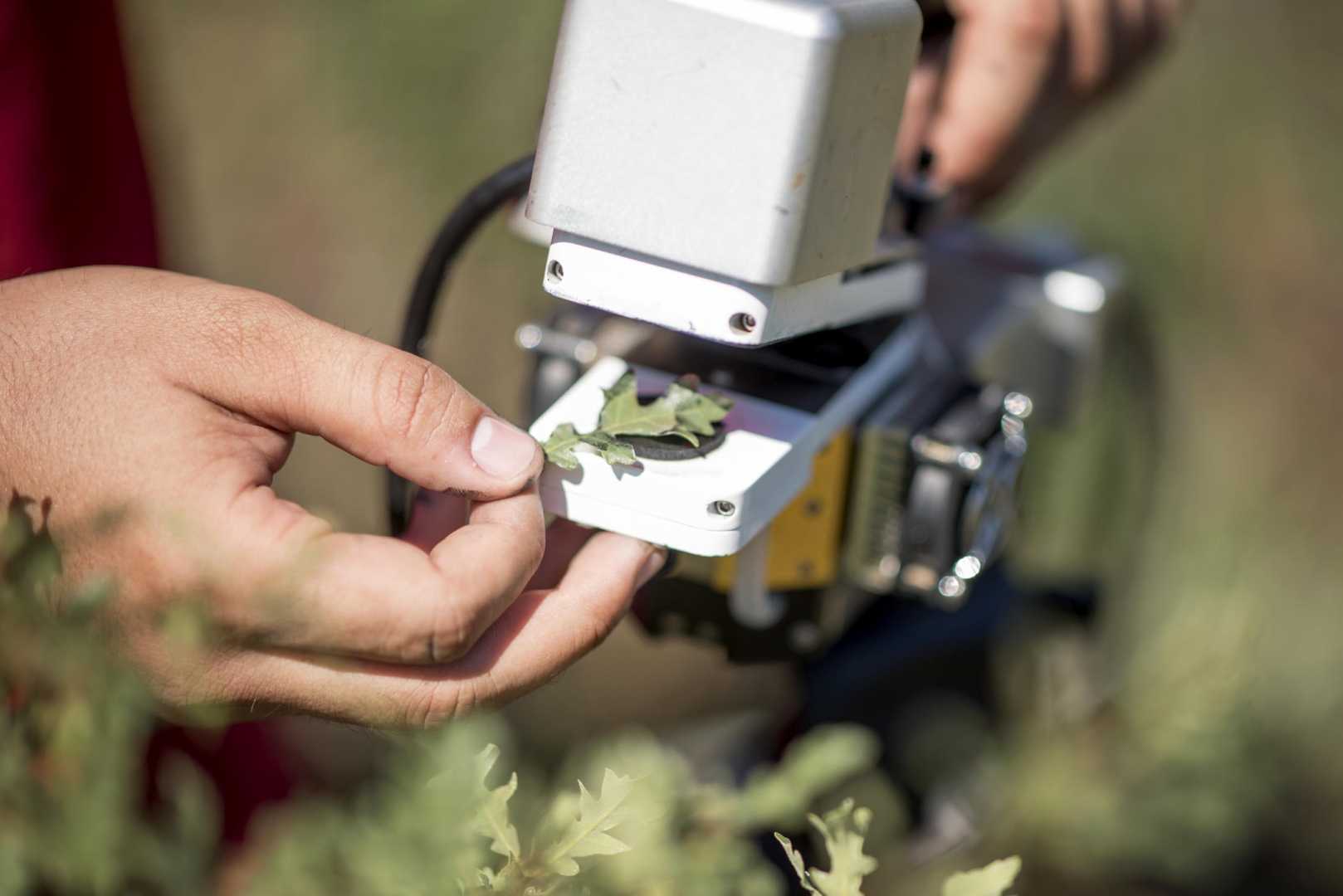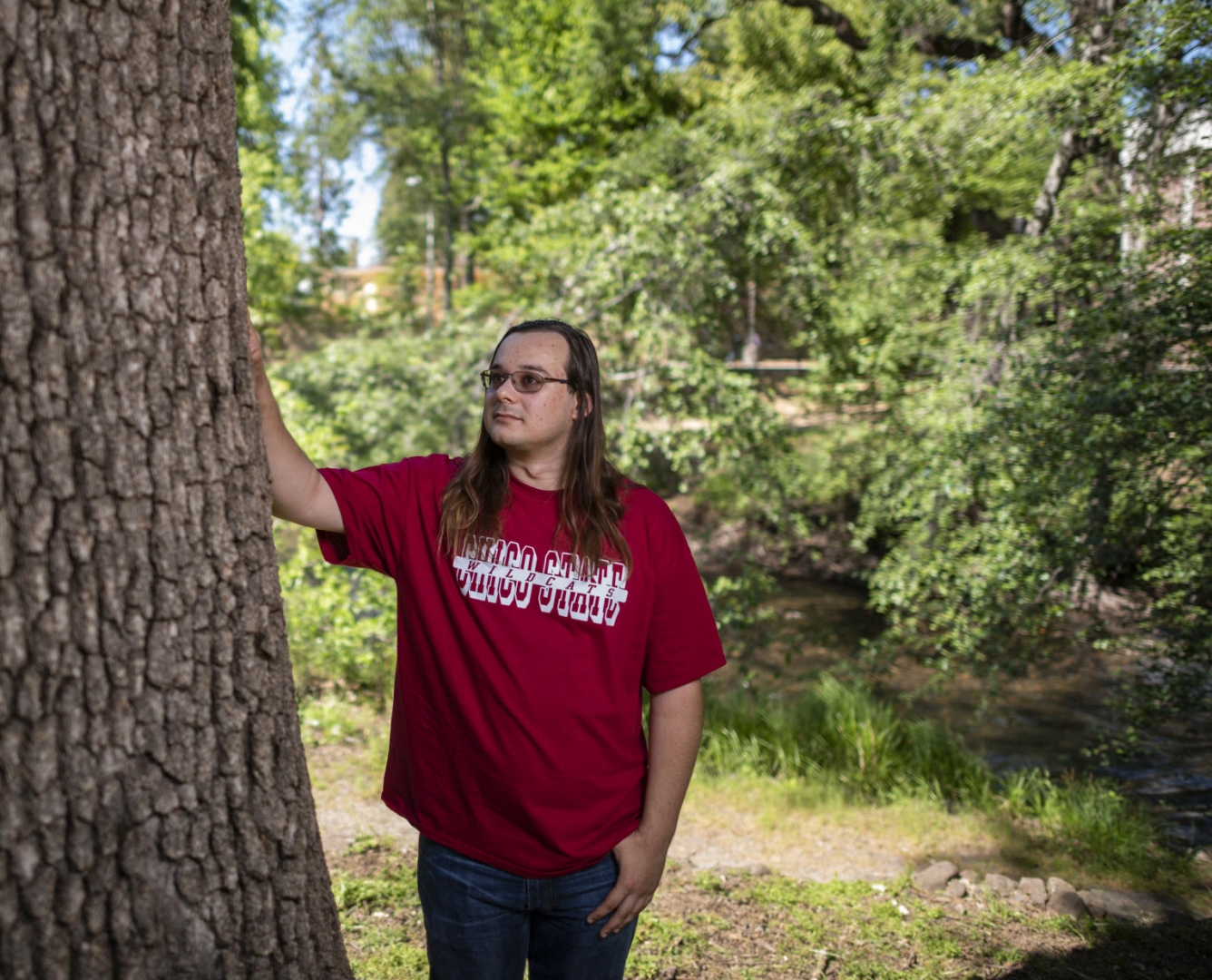Roots Resonate with Biology Major

He-Lo Ramirez is photographed near a native oak tree in the Creekside Educational Garden on Thursday, April 25, 2019 in Chico, Calif. Ramirez is a Mechoopda Tribe member and is studying plant science. He is having a paper published about a study he conducted on one of Chico’s native oak tree species. He is also in the process of receiving a grant to implement a community garden by the creek to reintroduce native plants to the area. (Jason Halley/University Photographer/CSU Chico)
Putting down roots. This is a notion that He-Lo Ramirez knows to his core, not only as an academic and novice botanist, but also through his ancestral connections to the Chico area.
As a member of the Mechoopda Indian Tribe, the ancestral community historically located on Little Butte Creek, Ramirez is a senior studying biology with the option in ecological, evolutionary, and organismal science. Throughout his studies, he blends his passion for ecology and his ethnobiological lens to initiate environmental change in his community.
Ramirez transferred to Chico State from Butte College as a junior, and as a first-generation student, he was confronted with numerous transitional challenges. These included securing funding for his tuition, navigating programs related to his major, and establishing connections with campus resources that would provide avenues to pursue his interests.
However, he quickly found his footing in the biology department. Ramirez began his first semester by enrolling in a plant biology course taught by Professor Christopher Ivey, who immediately recognized his outstanding qualities as a student and potential researcher.
“He-Lo quickly stood out from the others and surprised me by his ability to grasp and synthesize challenging material during class discussions,” Ivey said. “He was consistently a leader during discussions and kept the class productive in a way I have rarely seen in undergraduate students.”

When Ramirez expressed interest in research, Ivey enthusiastically integrated him into his ongoing garden experiment on native valley oak trees. The project required painstaking and tedious data collection that often had to be done outdoors under inclement weather conditions, but Ramirez embraced it with enthusiasm.
It wasn’t long before he branched into conducting his own research on valley oaks.
For his study, he is examining the variation of valley oak leaf shapes across different populations throughout California. He’s specifically curious whether shape variation affects the plant’s physiological features, such as photosynthesis and water-use efficiency.
Ultimately, he wants to determine if changing leaf shape implies certain valley oak varieties are simply more equipped to resist environmental stressors, or if they are capable of changing their leaf shape to best suit their current environment—which could ensure their resilience in the face of drought stress and climate change.
His motivations are as personal as they are academic.
Throughout history, Ramirez explained, there has been a disconnect between Western science and traditional Native American environmental knowledge, and only recently has Western science confirmed already established Native American practices. Part of this disconnect, he said, is disregarding the historical and ecological importance of native plants such as the valley oak.
“Valley oak acorns were a principle food source for Mechoopda people,” he explained. “Currently, 90 to 95 percent of valley oaks are gone from the local population. … I am worried about how they are going to do in the future, and I just want to know more.”

Funding to support Ramirez in his research in this significant native plant was made possible by Chico STEM Connections Collaborative, a University program that supports underrepresented students pursuing STEM majors.
Ramirez has been presenting his research findings at conferences and universities around the nation. After earning the top prize for his poster among hundreds of entries at the national Botany 2018 conference, he presented at the Northern California Botanists’ 2019 Botanical Symposium, where he was approached by the peer-reviewed scientific journal published by the California Botanical Society, Madroño.
The journal urged him to submit his work for publication. His educational status as an undergraduate makes him a rarity among fellow authors, but that has not dissuaded him on working on a final draft.
“I have never even worked with a graduate student who has taken the lead on preparing a manuscript for submission to a peer-reviewed journal,” Ivey said. “It’s far beyond my wildest hopes that an undergraduate would show such initiative.”
Meanwhile, Ramirez continues sharing his love for science with students in the community. In addition to being a member of Omicron Theta Epsilon, the biology honors society, he also volunteers his time to judge posters at the Chico Science Fair and participates in K–12 schools’ Science Nights helping with hands-on experiments and museum visits.
He is also working with the University’s Facilities Management and Services to establish an ethnobotanical garden along Big Chico Creek as it winds through campus.
Funded by an AS Sustainability Grant that Ramirez composed and submitted, he has over 20 species of native plants and flowers selected for the garden. Brodiaeas and lilies in bright blues, purples, and oranges will soon proudly speckle the creekside—each having a special significance for the native populations, he said.
Because the campus sits on land that was originally occupied by the Mechoopda people, the plants Ramirez is working to reintroduce were once part of the campus environment but have been replaced by invasive and non-native species—an all-too-common practice in today’s society, he said. He hopes this garden will return these vital native plants to campus grounds, as well as the appreciation people have for them.
“I feel like people undervalue the native plants here because of myths: one being that they are ugly, and the other being that they are unnecessary,” Ramirez said, noting the garden will be open to the entire community as a place to admire, tend to, or pick native plants and flowers. He hopes it will inspire the greater community to embrace them in their own yards and spaces.

After graduation, Ramirez will continue his education through the RiSE program at Chico State’s School of Education, where he will earn his teaching credential and his master’s degree.
He eventually hopes to share his knowledge by teaching students in Native American charter schools. He is adamant about revitalizing the knowledge and appreciation for native plants in Northern California, while also helping Native American youth appreciate the world in which their roots are planted.
“He is truly a remarkable young man with outsize potential,” Ivey praised. “It’s wonderful to see the growth and maturity in a student such as He-Lo—these are the kind of experiences that keep us going as teachers.”


